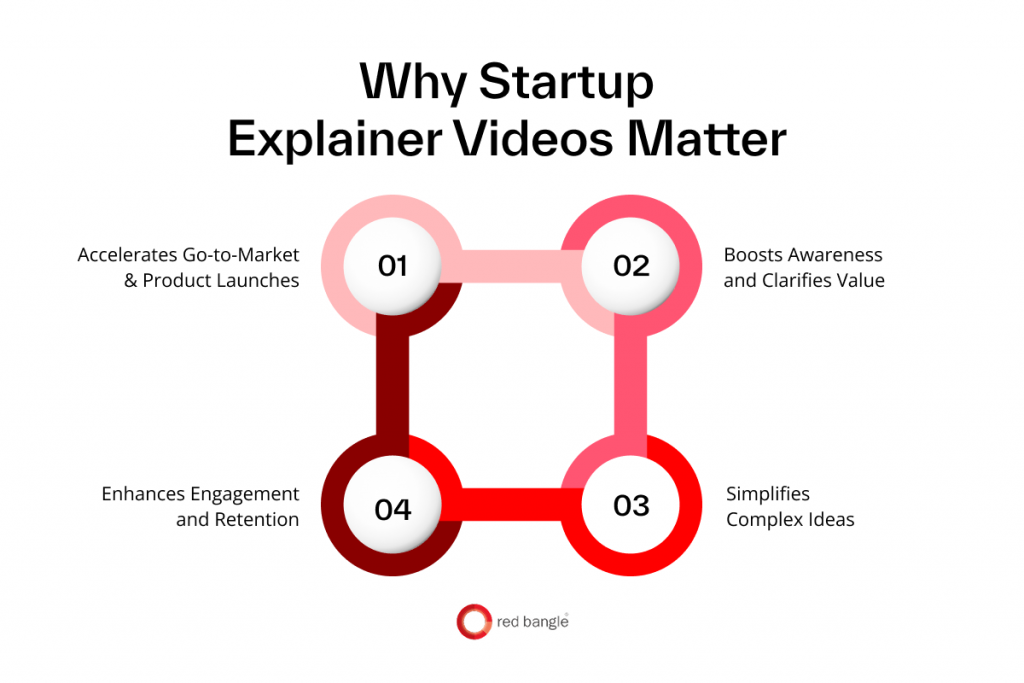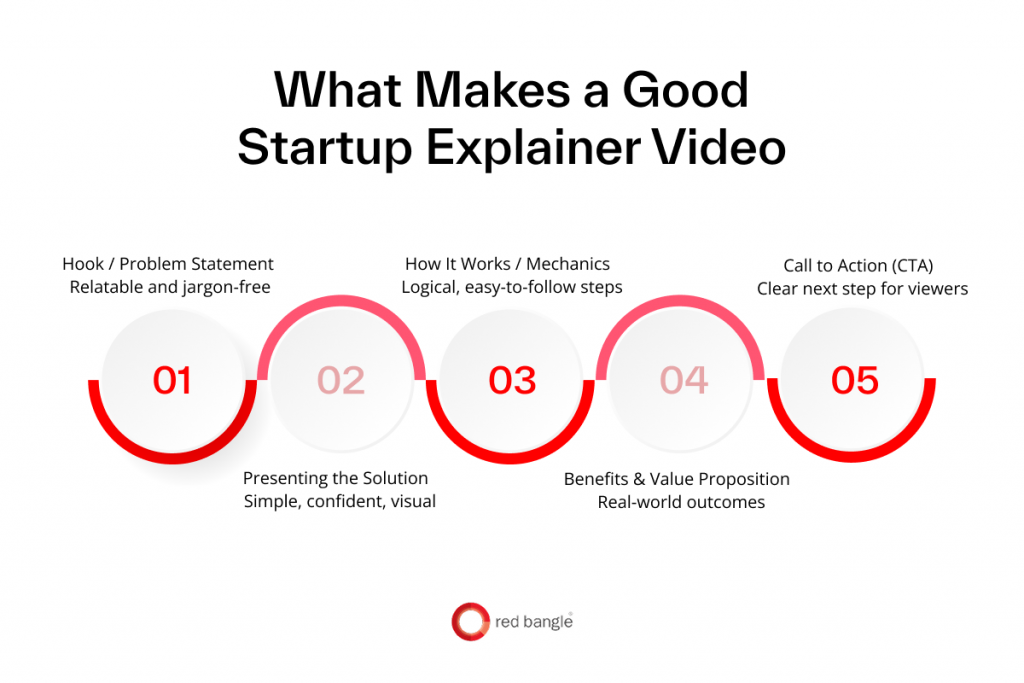Introduction
If you run a startup, you already know this: getting people to understand your product is harder than building it.
Not because your idea is complicated, but because everyone you speak to is busy, distracted and already hearing twenty other pitches that day. You might have only a few seconds to make them curious, and if you miss that window, it is gone.
That is where startup explainer videos can help.
These explainer videos are short, focused and built to make your value clear right away. A good one can take something that feels abstract and turn it into a simple story your audience remembers. They do not try to list every single feature, but instead choose the right angle, pace it well and show the difference your product can make.
Think of them as your communication shortcut. Instead of spending ten minutes walking someone through your product, you can share a 90-second video that makes them nod along and say, “Got it.” And because they combine visuals, sound, and storytelling, they stick in people’s minds far better than a paragraph of text or a static graphic ever could.
In this guide, we’ll look at real startup explainer video examples, break down why they work, and explore what makes one worth watching and sharing.
Real Startup Explainer Video Examples
Startup explainer videos are short, engaging visuals that simplify complex ideas, showcase products and communicate a startup’s value proposition in seconds. They help founders pitch to investors, attract early customers and boost brand recall.
These videos often use animation, live action or a hybrid style to present problems, offer solutions and drive action. They fit perfectly on websites, social media and pitch decks.
In 2025, high performing startup explainer videos are mobile friendly, under 90 seconds and tailored for quick viewer engagement, making them a proven tool for growth and funding.
When it comes to understanding what makes them effective, nothing beats seeing real examples. These B2B examples show how different formats, from animated explainers to live-action case stories, can hook an audience, clarify a message, and drive results.
1. The Red Bangle Explainer by Red Bangle
Format: 2D animated explainer
Duration: 1 min 27 secs
What Makes It Work:
Red Bangle takes a familiar pain point, the chaos of managing video production across formats, geographies, and teams, and distills it into a fast-paced, witty narrative. The script uses humour and vivid metaphors (“cross the seven seas for the right video crews”) to make the challenges relatable. The pacing is tight, the visuals are clean, and the transitions keep viewers engaged without overwhelming them.
Behind the scenes, this kind of seamless delivery comes from our process-driven workflows. Every brief, storyboard and review happens on our creative cloud platform so the team and the client always know exactly what is happening and when. With over 3,000 creative projects under our belt, we have fine-tuned how to keep production both agile and high quality.
Key Takeaway:
When your service solves a broad but urgent problem, anchoring the story in everyday frustrations makes the value proposition instantly clear. This is a strong template for animated video for startups that need to simplify operational solutions while keeping the tone approachable.
2. Slack’s “So Yeah, We Tried Slack…” Explainer
Format: Live-action explainer
Duration: 2 mins 21 secs
What Makes It Work:
Slack takes a playful mockumentary approach, showing a team’s shift from clunky, fragmented communication to a streamlined workflow in Slack. It feels unscripted and relatable, with humour woven into the storytelling, making the benefits more memorable than a standard feature demo. The integration mentions, visual cutaways, and casual interviews make it easy for viewers to picture themselves using the tool.
Key Takeaway:
If your startup relies on changing established habits, showing a “before and after” transformation through real people can create instant credibility and emotional buy-in.
3. WalkMe’s Digital Adoption Platform Explainer
Format: Motion graphics
Duration: 52 secs
What Makes It Work:
WalkMe positions its product as a bridge between complex technology and human productivity. The video uses clean motion graphics, a confident voiceover, and a clear narrative to link the platform’s value to broader outcomes like efficiency and success. It avoids feature overload, focusing instead on how the product empowers people to get the most out of their tools.
Key Takeaway:
When your product’s value lies in enabling other systems to work better, centering the story on human benefits rather than technical depth can make it resonate with a wider audience.
4. ‘What is Ahrefs?’ Explainer
Format: 2D animated explainer
Duration: 1 min 32 secs
What Makes It Work:
Ahrefs’ video is a masterclass in explaining a technical SaaS tool to a non-technical audience. It starts with a clear problem statement, contrasts the customer’s struggle with competitor success, and positions Ahrefs as the straightforward solution. The visuals simplify concepts like backlinks and ranking data, making them accessible to viewers without SEO expertise.
Key Takeaway:
For complex B2B tools, pairing visual metaphors with a problem-solution structure helps break down intimidating topics into digestible, action-oriented steps.
5. Beetexting – Business Texting CRM Explainer
Format: 3D animated explainer
Duration: 1 min 10 secs
What Makes It Work:
Beetexting uses a clean, step-by-step walkthrough to highlight features while keeping the focus on real business use cases. The animation shows exactly how teams can collaborate, automate replies, and integrate with existing tools, making it easy for viewers to picture how they would use it. The mix of practical examples and smooth visuals helps anchor credibility.
Key Takeaway:
If your startup has multiple features, grouping them into clear workflows can help prevent feature fatigue while still demonstrating depth.
6. Asana Explainer
Format: 2D animation without voiceover
Duration: 1 min 25 secs
What Makes It Work:
Asana’s text-driven explainer proves that you do not need voiceover to make an impact. The visuals and on-screen text create a seamless, focused experience that highlights collaboration and clarity. By showing teams “working in flow,” it conveys both function and feeling in a short runtime.
Key Takeaway:
When brand tone and design are strong, a voiceover is optional. Sometimes, less audio allows the visuals and copy to work harder together.
Why Startup Explainer Videos Matter
When you are building a startup, clarity can decide whether your idea takes off or gets overlooked. You might have an incredible product, but if people cannot quickly grasp what it does and why it matters, you will lose them. Startup explainer videos solve that problem by delivering your story in a format that is fast, engaging, and easy to remember.
They are more than a marketing asset. They are a way to communicate value across audiences, from customers and partners to investors and even your own team. Here is why they matter so much for early-stage businesses.

1. Accelerates Go-to-Market and Product Launches
Speed is often your biggest advantage as a startup. A well-crafted explainer video for startup launches can act as a single, reusable asset that tells your story to every audience you need to reach.
Instead of preparing multiple slide decks or lengthy onboarding calls, you share one short video that communicates the essentials in minutes. It creates consistency in your messaging and helps you make an impact right from the start.
In our work with early stage startups, speed is often the make or break factor. That is why we match you with the right creative talent from our 1,000+ global collaborators and use our platform to streamline every step from briefing to final delivery. The result is on brief, on time and on budget videos that are ready to roll out across markets without delay.
2. Boosts Awareness and Clarifies Value
When you are the new player in the market, people do not yet know who you are or what you do. The best startup explainer videos make your value proposition instantly clear. They combine storytelling, visuals, and a clear structure to show the problem you solve and the results you deliver.
This makes it easier for potential customers or partners to remember your brand and associate it with a specific benefit.
In fact, 64% of B2B buyers are more likely to make a purchase after watching a video that explains a product or service clearly and concisely. That instant clarity can be the difference between a prospect moving forward or losing interest.
3. Simplifies Complex Ideas
If your product is technical or data-heavy, explaining it with words alone can feel overwhelming. An animated video for startups can use visuals, simple language, and pacing to make even advanced concepts feel approachable.
Instead of overwhelming your audience with detail, you guide them step-by-step, showing how your product works and why it is useful, without them needing any prior expertise.
4. Enhances Engagement and Retention
Videos hold attention better than most other formats. They combine sight, sound, and motion to keep viewers focused, making it more likely they will stay to the end.
Short-form content is particularly effective. 93% of marketers say short-form videos help them acquire new customers, and 21% say they deliver the highest ROI of any format in 2025.
And because a startup explainer video is easy to rewatch or share, it extends your reach long after the first viewing. This repeat exposure helps reinforce your message, making it more memorable over time.
What Makes a Good Startup Explainer Video?
Every strong explainer video follows a structure that guides the viewer from curiosity to action. It is not about cramming every feature into 90 seconds. Instead, it is about creating a smooth flow that captures attention, explains value, and inspires the next step.
Here are the five elements we focus on when creating or evaluating an explainer video for startups.

1. Hook / Problem Statement
The opening seconds decide whether your audience will keep watching. A good hook taps into a real pain point your viewers are facing. This might be a frustration they deal with daily, a missed opportunity they wish they could capture, or an inefficiency that slows them down. The best hooks speak in plain language and make the viewer think, “Yes, that’s my problem.”
Key points to include in the hook:
- Use relatable scenarios your audience will recognise instantly.
- Keep the problem statement short and impactful.
- Avoid technical jargon in the first few seconds.
2. Presenting the Solution
Once you have their attention, introduce your product or service as the natural answer to the problem you have just described. Keep the explanation simple and confident. Instead of diving into every feature, show the transformation your solution creates. This is where the explainer video for startup brands builds trust.
How to present the solution effectively:
- Focus on one core idea first before adding detail.
- Show the solution in action, not just as a concept.
- Use visuals that make the benefits obvious without explanation.
When we craft explainer videos, we do not just jump into production. At Red Bangle, we spend time clarifying your business context and audience, and if we think you would benefit more from a testimonial or product demo than a traditional explainer, we will tell you. Startups often tell us this guidance upfront saves them both time and budget and ensures the final video actually drives results.
3. How It Works / Mechanics
After showing the solution, walk your audience through how it works in a logical sequence. This part should feel easy to follow, even for someone unfamiliar with your industry. Whether it’s an animated walkthrough or a real-life demonstration, aim for clarity above all.
Tips for explaining mechanics clearly:
- Break the process into 3–5 simple steps.
- Use clean, uncluttered visuals that match your narration.
- Highlight key features in context, not in isolation.
Research also shows that short 2–15 minute animations are the most used, with effective recall seen especially in 1–8 minute videos. That’s why pacing is crucial. You want viewers to stay engaged and remember what they’ve just seen.
4. Benefits and Value Proposition
Features are important, but benefits are what your audience really cares about. This section should make it clear how your product changes their experience, solves their challenges, and delivers measurable value. Link each benefit back to the problem you introduced earlier.
Ways to communicate benefits effectively:
- Translate features into real-world outcomes.
- Use language that speaks directly to the viewer’s priorities.
- Keep benefits concise so they are easy to remember.
5. Call to Action (CTA)
The most engaging startup explainer videos end with a clear and compelling next step. This is your chance to turn attention into action. Whether it’s booking a demo or signing up for a free trial, the CTA should feel like a natural conclusion to the story.
Best practices for CTAs in explainer videos:
- Use active, action-oriented language.
- Keep it short and direct (one clear action only).
- Make the CTA visually stand out in the final frames.
What Should a Startup Explainer Video Cover?
Startup explainer videos are not just about showing your product in action. It should give viewers a clear sense of who you are, what you stand for, and why they should trust you. The content you include will depend on whether you are speaking to customers, investors, or even your own team for onboarding.
Here are four core elements we recommend covering to make your video both informative and memorable.
1. Team and Human Touch
People connect with people, not just products. Showing the team behind the idea adds authenticity and makes your brand more relatable. Even in a product-focused video, a brief human element can build trust faster than any feature list.
How to add the human touch:
- Show quick clips of founders or key team members.
- Share the “why” behind your product in simple terms.
- Use friendly, approachable visuals or tone.
2. Market Context and Competitive Edge
Your audience should walk away knowing exactly why your startup is different from others in the market. Without this, even the most engaging video risks blending in with competitors.
Ways to highlight your edge:
- Briefly frame the problem in the context of your industry.
- Call out what makes your solution unique without overselling.
- Use clear comparisons or visuals to show differentiation.
3. Vision or Forecast
A startup is more than its current product. If applicable, share where you are headed. This can be inspiring for customers and reassuring for investors. It shows you have a plan for growth and innovation.
Tips for presenting your vision:
- Keep it high-level to avoid overwhelming viewers.
- Focus on the impact you want to create in the future.
- Use visuals that suggest progress, expansion, or possibility.
4. Business Model Insights (for investors)
If your explainer video is investor-facing, they will want to know how your startup makes money. This does not mean a full financial breakdown, but a quick look at the model builds credibility.
What to include for business model clarity:
- State the revenue streams simply.
- Show proof of traction or early adoption if available.
- Keep it concise so it complements, rather than replaces, your pitch deck.
Including these elements turns your startup explainer videos into more than a product demo. It becomes a clear, persuasive story your audience remembers.
Conclusion
Startup explainer videos are the most versatile tools you can create. It distills your vision, product, and value into a format your audience can understand and remember in minutes. When done well, it builds trust faster, helps you stand out in competitive markets, and drives action long after the video ends.
Now that you know what works and what to include, the question is: how will you tell your story? At Red Bangle, we help startups craft high-impact explainer videos that engage, educate, and convert.
Over the years, we have created explainer videos for startups across industries from crisp 60 second animations to global, multi language live action shoots. Our clients trust us because they never have to chase deadlines, align multiple vendors or wonder where their assets are. Everything is organized, reviewed and delivered through our platform so they can focus on growing their business while we handle the storytelling.
Ready to bring your story to life? Book a call with our team and talk to an expert today.

Leave a Reply